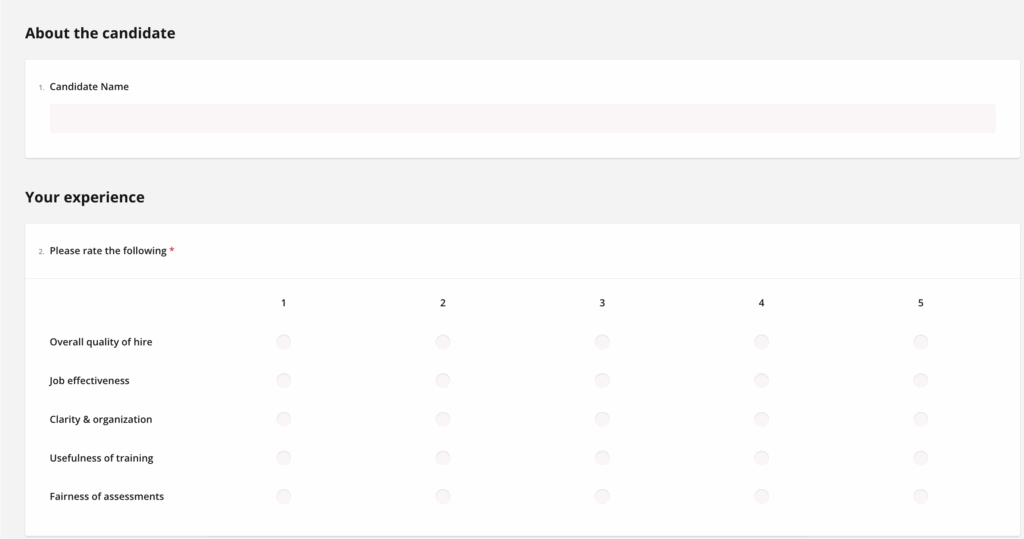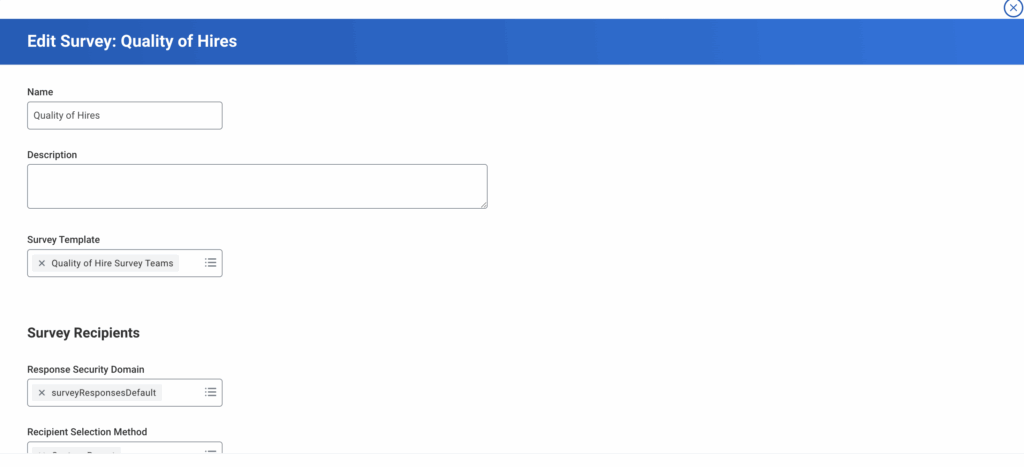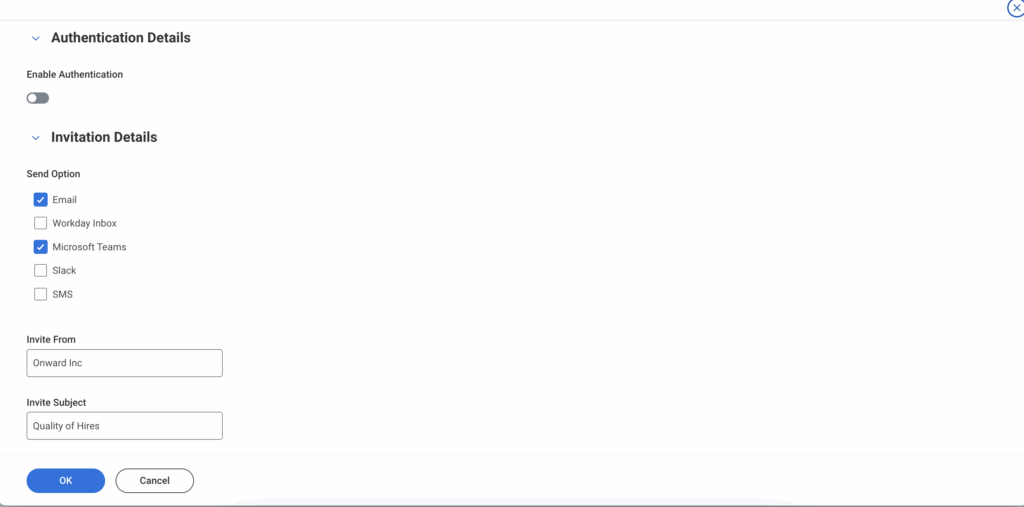Quality of hire survey (QoH) measures how well a new employee contributes to the company’s success, often encompassing factors like performance, retention, and cultural fit. In this bog, we detail why quality of hire surveys matter, the risks of not collecting post-hire feedback, evidence from research on QoH outcomes, and how built-on Workday survey tool OnSurvey can help with the Quality of Hire survey.
“Did we hire the right person who will perform and stay?” A million dollar question that can make or break the team. A high-quality hire boosts team productivity, strengthens culture, and improves retention, whereas a poor hire can do the opposite. In fact, quality of hire has been called “the deepest-impact metric HR can utilize to increase workforce productivity, improve retention, and realize organizational goals”. It directly measures the value a new employee contributes to the company’s success, linking talent acquisition to tangible business outcomes .
Quality of hire is also a top priority for modern talent acquisition. In a recent industry survey, 31% of recruiters named quality of hire as their number-one performance metric – above first-year retention (23%) and time-to-hire (21%). Combining QoH with retention (often considered a core component of quality) puts it at the center of over half of recruiting performance dashboards . In other words, HR leaders recognize that measuring quality of hire tells the full story of recruiting’s value, encapsulating how new hires ultimately perform and stick with the company. By focusing on quality of hire, organizations can continuously refine their hiring practices to drive better business results.
Moreover, quality of hire surveys provide a structured way to gather feedback on new hires’ progress. Typically conducted after 30, 60, or 90 days (and sometimes at 6 or 12 months), these surveys ask hiring managers about the new employee’s performance, fit, and ramp-up time. This feedback loop helps HR quantify things like how quickly a new hire reaches full productivity, how well they meet performance expectations, and how engaged they are early on. In short, quality of hire surveys matter because they turn subjective impressions about a new hire into data-driven insights.
First challenge is defining “quality” means for each organization. It’s a multifaceted metric that can include performance ratings, retention, cultural fit, time to productivity, and more. Since success looks different for each role, some companies find it tricky to set a one-size-fits-all formula for quality of hire. Despite these challenges, not collecting post-hire feedback at all is far riskier. When organizations neglect quality of hire surveys and feedback, they face several key risks:
Repeating Hiring Mistakes: Without data on how new hires are performing, companies remain “in the dark” and risk repeating the same recruiting mistakes. Hiring decisions stay based on gut feeling rather than evidence. This means if a particular source or interview practice is leading to poor hires, it may never be discovered and corrected.
Financial Costs of Bad Hires: Poor-quality hires can hit the bottom line. On average, a bad hire can cost a business about 30% of that employee’s first-year earnings in wasted salary alone. The true cost is often higher when you factor in recruitment expenses, training time, lost productivity, and the cost of replacing the individual. Failing to collect feedback means failing to catch underperforming hires early, resulting in longer-term financial drain.
High Turnover and Disruption: New hires who are not a good fit tend to leave early or underperform. This drives up turnover rates and can create a churn cycle where teams are constantly rehiring and retraining replacements. Even worse, if a poor hire stays on, their underperformance can frustrate colleagues and drag down team productivity. Research indicates a single bad hire in a team can cause a 36% drop in productivity for that team. Not gathering quality feedback means an organization might miss warning signs until turnover or team issues become acute.
OnSurvey is a built-on Workday app that makes it easy for HR teams to create, distribute, and analyze surveys directly within Workday. In other words, it brings the feedback loop inside your HR system of record. With OnSurvey, there’s no need for separate survey platforms or manual spreadsheets. In sum no data exports and no external tools are required. The entire process stays in Workday, resulting in secure, real-time feedback collection that seamlessly ties back to employee records.

Because OnSurvey is native to Workday, it leverages the full power of the Workday platform. HR business partners and recruiters can trigger surveys automatically based on Workday events (such as a new hire’s 30-day work anniversary or completion of onboarding) and capture responses from managers, peers, or the new hires themselves. All the data is stored under the same security and privacy controls that govern your HR data in Workday . This means sensitive feedback is protected and accessible only to authorized users, giving organizations confidence in the confidentiality and integrity of the survey process. OnSurvey essentially embeds the quality of hire survey workflow into the flow of work for HR making it effortless to gather feedback at key moments without juggling multiple systems.
OnSurvey is designed to execute quality of hire surveys from start to finish, all within Workday.
Event-Triggered Surveys: OnSurvey can automatically fire off surveys when specific events occur in Workday. For example, you could set a quality-of-hire survey to send to a hiring manager 60 days after a new employee’s start date (or at any Workday business process step, like the completion of probation) . This event-driven approach ensures feedback is collected promptly at the moment it’s most relevant – without HR having to remember to launch surveys manually.
Integrated Workday Data Context: Because it’s built into Workday, OnSurvey can pull in contextual information like the new hire’s department, role, location, or team directly into the survey experience. You can dynamically merge Workday fields into survey questions or answer options . For instance, a survey to peers can automatically reference “John Doe in the Marketing department” so respondents know who the feedback is about, without HR crafting separate surveys for each hire. This tight integration means responses can also be segmented by attributes (e.g. compare quality-of-hire scores by department or job level) using the rich data already in Workday .
Secure, In-Platform Response Collection: All survey responses via OnSurvey are captured within your Workday tenant, not an external system. The data never leaves Workday and is governed by existing security domains and permissions. Inheriting Workday security domain is a major advantage as HR doesn’t have to export data to third-party tools or worry about uploading spreadsheets of feedback. It reduces risk and compliance concerns, as sensitive feedback (especially if it includes candid manager comments or peer reviews) stays encrypted and controlled in one system of record.

One-Stop Survey Management: OnSurvey consolidates what used to be a patchwork of tools into one place. No more jumping between an ATS, an external survey app, and Excel – everything from survey design to distribution to analysis happens inside Workday . This one-stop approach not only saves time but also ensures one source of truth for talent feedback. All the quality-of-hire data ties back to the employee’s profile and can be easily combined with other HR metrics.
By leveraging these capabilities, HR business partners can run a robust Quality of Hire survey program in no time. OnSurvey essentially operationalizes best practices that industry experts recommend – such as surveying at multiple intervals (e.g., 30, 90, 180 days) and involving hiring managers in rating new hire success but does so in an automated, scalable way. The result is a more proactive talent management strategy: potential issues with new hires are flagged early, and successful hiring practices become visible through data. In short, OnSurvey provides a modern, feedback-driven approach to ensure the organization is hiring not just quickly, but effectively.
Here is a demo that shows how OnSurvey can be used for Quality of Hire Surveys.
We encourage you to try OnSurvey and experience how a smarter feedback loop can elevate your hiring outcomes. Your journey to better hires and better business results could start with the next survey you send out. Get started today and let quality of hire data guide you to continuous talent success.
RELATED
